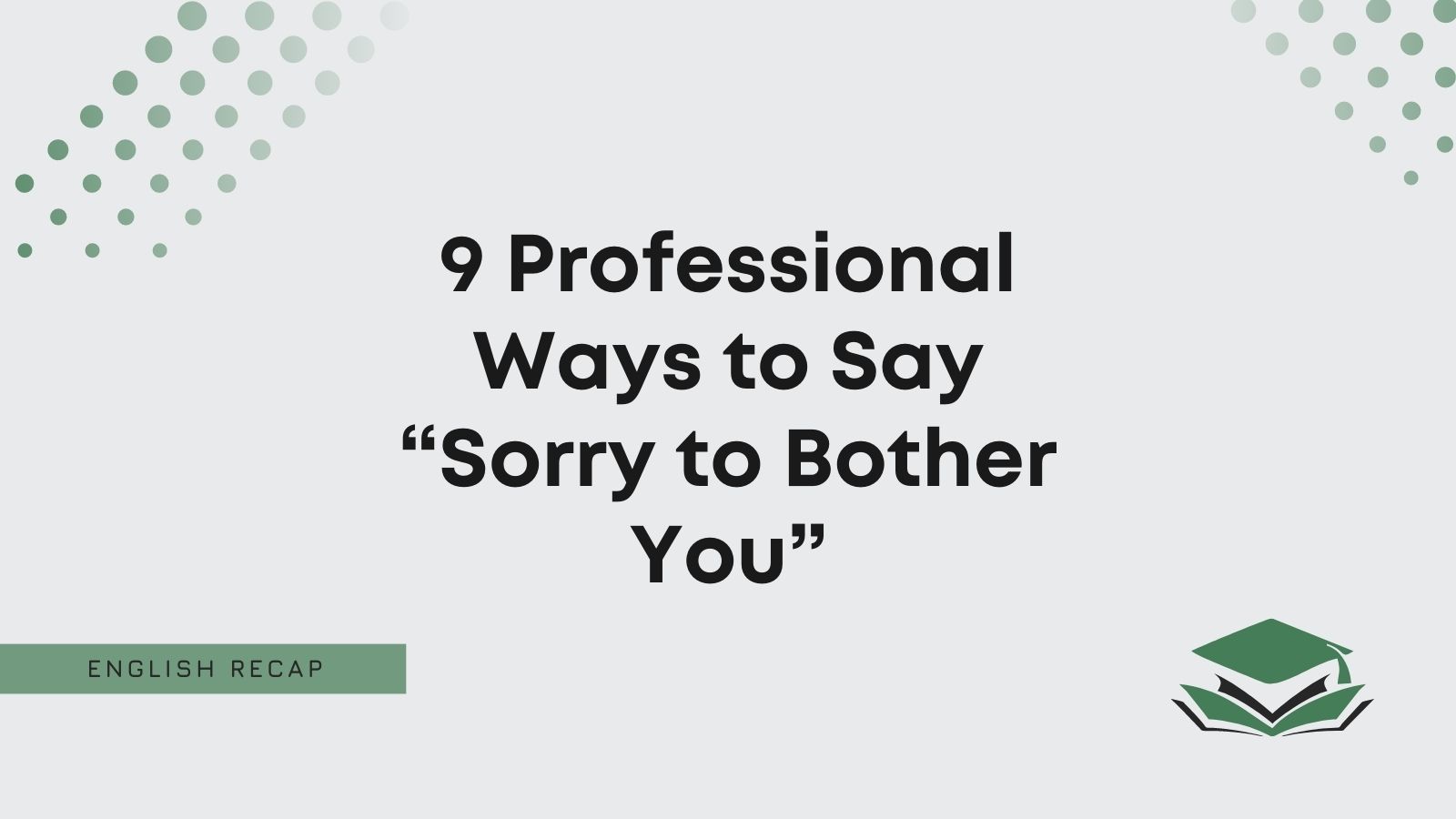It can be hard to contact busy people. After all, nobody wants to interrupt someone’s busy work day.
But sometimes, it’s necessary.
You might be thinking about “sorry to bother you” when emailing someone at work. But is it the most professional option?
This article will explore all the alternatives to help you mix things up.
Is It Professional to Say “Sorry to Bother You”?
It is not professional to say “sorry to bother you” in an email. It is informal and does not work if you truly want to respect someone and their busy schedule.
You should not say it in an email. Many better professional alternatives avoid the word “bother.” We recommend using one of those to keep things as formal as possible.
Still, you can use it in this situations, but only use it informally:
I’m so sorry to bother you, Adam. I certainly didn’t realize you were busy!
Pros
- It’s a polite way to show that you don’t want to distract someone.
- It’s friendly and works in informal contexts.
Cons
- It’s not the most formal option.
- You shouldn’t use it when contacting a superior.
So, “sorry to bother you” is clearly not the most suitable choice in formal emails. Nevertheless, you have options to give you a professional way to say “sorry to bother you.”
Keep reading to find out how to say “sorry to bother you” in an email. You can also review the examples provided to see how they work.
What to Say Instead of “Sorry to Bother You”
- I’m sorry for reaching out
- I know you’re busy, and I’m sorry
- I hope I’m not interrupting
- I hope this doesn’t inconvenience you
- I hope this doesn’t come at an inconvenient time
- Sorry to burden you with this
- I apologize for the repeated request
- Sorry to bring this up again
- I appreciate your busy schedule, but
1. I’m Sorry for Reaching Out
You could write “I’m sorry for reaching out” instead of “sorry to bother you.” It’s an excellent alternative that helps you to sound remorseful yet polite when reaching out to someone.
In this instance, you can use “reaching out” when contacting a client. It shows you have to contact them, even though you know they might be busy.
It’s worth using if you’re trying to maintain a polite and friendly dynamic with your clients.
Check out this example to see how it works:
Dear Mr. Bennett,
I’m sorry for reaching out again. However, I need you to confirm whether we’re moving forward with our plans.
Yours,
Duncan Bannatyne
2. I Know You’re Busy, and I’m Sorry
This one is a two-parter. Both parts are important, so we’ll talk about them both.
First, you can say “I know you’re busy.” This is a respectful way to address someone’s busy schedule. You should use it when you regret having to contact someone.
Second, you add the simple apology “I’m sorry.” This keeps things formal and polite between you and the recipient.
You should try using it when contacting your boss. They won’t mind the intrusion as much if you use a phrase like this before asking your question.
This email sample should also help you understand it:
Dear Ms. Bryant,
I know you’re busy, and I’m sorry to disturb you. However, do you have any updates that might help us move things forward?
Best wishes,
Steven Rogers
3. I Hope I’m Not Interrupting
Another way to say “sorry to bother you” is “I hope I’m not interrupting.” It’s very polite and shows that you do not want to interrupt someone’s schedule.
However, sometimes, important things come up. You can’t just wait for someone’s schedule to free up before talking to them.
You can use it to email an employee. Maybe you’ve set them a difficult task to complete, but you need to quickly distract them with something new.
This is a great way to remain polite while asking them to pay attention to your email.
Check out this email example as well:
Dear Carla,
I hope I’m not interrupting you at this time. I still need to hear from you regarding my previous email, though.
Best regards,
Sean Wallace
4. I Hope This Doesn’t Inconvenience You
You can also write “I hope this doesn’t inconvenience you.” It works well because it shows that you do not want to upset the recipient.
Using “I hope” is a very polite way to keep up a positive and friendly tone. We recommend using it when contacting colleagues, especially if you know they’re busy working on some other projects.
If you’re still unsure, you can refer to this sample email:
Dear Matilda,
I hope this doesn’t inconvenience you or your busy schedule. However, would you be free to discuss this over lunch?
Yours,
Damian Woodridge
5. I Hope This Doesn’t Come at an Inconvenient Time
In the workplace, you never really know what times might be inconvenient for someone until you ask. Try using “I hope this doesn’t come at an inconvenient time” as well.
It’s a great option that shows you hope you catch someone while they’re not busy. It’s respectful and shows that you’d appreciate it if they could reach out and help you with something.
Here’s a great email sample to help you as well:
Dear Carl,
I hope this doesn’t come at an inconvenient time, but I need to know what your verdict is before I continue.
Yours,
Erik Samwise
6. Sorry to Burden You With This
Although it’s quite a negative phrase, “sorry to burden you with this” is a good synonym for “sorry to bother you.” However, you should only use it when emailing your boss.
The phrase sounds quite submissive. It won’t work well if you’re contacting clients or customers because it suggests you’re not in control of the situation.
Instead, stick to it when interrupting your boss’ schedule. It’s an honest way to show that you respect them. It also suggests that you’d like their forgiveness because you disturbed them.
We also recommend the following example:
Dear Katie,
Sorry to burden you with this again, but you’re the only person I can turn to when looking for help.
All the best,
Steven Frederickson
7. I Apologize for the Repeated Request
Feel free to try “I apologize for the repeated request” in some instances as well. It’s a good option when reaching out to your boss because you need their assistance.
Starting the phrase with “I apologize” keeps things honest and formal. You should use it when you don’t want to ask for help again but can’t find a better way to do things.
Also, this phrase implies that you’ve already requested help in the past. It might be possible that your boss has already ignored your request, but it’s still worth asking them to see if they’ve changed their mind.
This sample email should also help you with it:
Dear Ms. Keating,
I apologize for the repeated request. I promise this will be the last time, but I really need your help.
Kind regards,
Janet Joking
8. Sorry to Bring This Up Again
Another good choice when contacting your boss is “sorry to bring this up again.” It shows that you’ve already asked for help, but you still need to hear from the recipient.
You should use it in a follow-up email when your boss hasn’t replied.
After all, it’s very easy for your boss’s inbox to clog up. They may have simply missed your original email and might need a reminder to look into it.
Here’s a great example to show you how it works:
Dear Mr. McLaughlin,
Sorry to bring this up again, but have you heard anything more about my application?
Thank you so much,
Sam Bell
9. I Appreciate Your Busy Schedule, But
Finally, you may use “I appreciate your busy schedule, but.” It’s a very classy way to show respect to a client.
“I appreciate your busy schedule” is really polite. Hopefully, the recipient will appreciate this and do what they can to answer your question or help you.
However, there’s never a convenient time to ask for help in most business contexts. So, you need to rely on phrases like this to help you out.
Check out this example if you’re still unsure:
Dear Mrs. Humphries,
I appreciate your busy schedule, but I would like to discuss some of this with you further.
All the best,
Rowan Matinee

